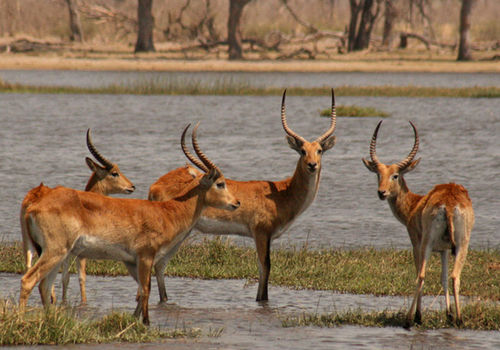
Red lechwe
Kobus lecheRed lechwe
Introduction: Red lechwe (Kobus leche) are a medium-sized antelope, rarely found more than 2 or 3km from permanent water. After the sitatunga, the lechwe is the most water loving antelope. It has no hesitancy about heading for water to escape predators or to feed. This is to their advantage as they are not particularly fast on land and have a poor sense of smell. Lechwe are gregarious and herds of 15 - 20 are common, growing to aggregations of thousands. Bachelor herds only break up in the mating season and only males carry the lyre-shaped horns.
Lechwe are active before sunrise in the early morning and later in the afternoon until shortly after after sunset. They rest in the hotter parts of the day and at night lie near the water's edge. The herds scatter into smaller groups when disturbed to avoid being preyed upon by lion and leopard. Long, deeply splayed hooves allow movement in mud.
Distribution: They are common in the eastern Zambezi Region (formerly the Caprivi Strip) as well as in the Linyanti Swamp.
Diet: Red lechwe are almost exclusively grazers, feeding on semi-aquatic grasses. They are known to rarely drink water in the cooler, dry season, but during the hot, dry season they drink an average of 3 times a day.
Colouring: A coat of long, rough hair is almost reddish-yellow in colour on the upper parts of the body and flanks.
Breeding: Gestation period is 210 - 240 days. A single calf of about 5kg is produced at birth. They leave the herd when about to give birth to drop their calves in tall grass. The mother returns to suckle her young in the early morning and late afternoon. Calf mortality is well over 50% due to predator activity.
Size: Males are around 1m in height and weigh some 125kg. Females are slightly smaller and lighter.
Klein Windhoek

